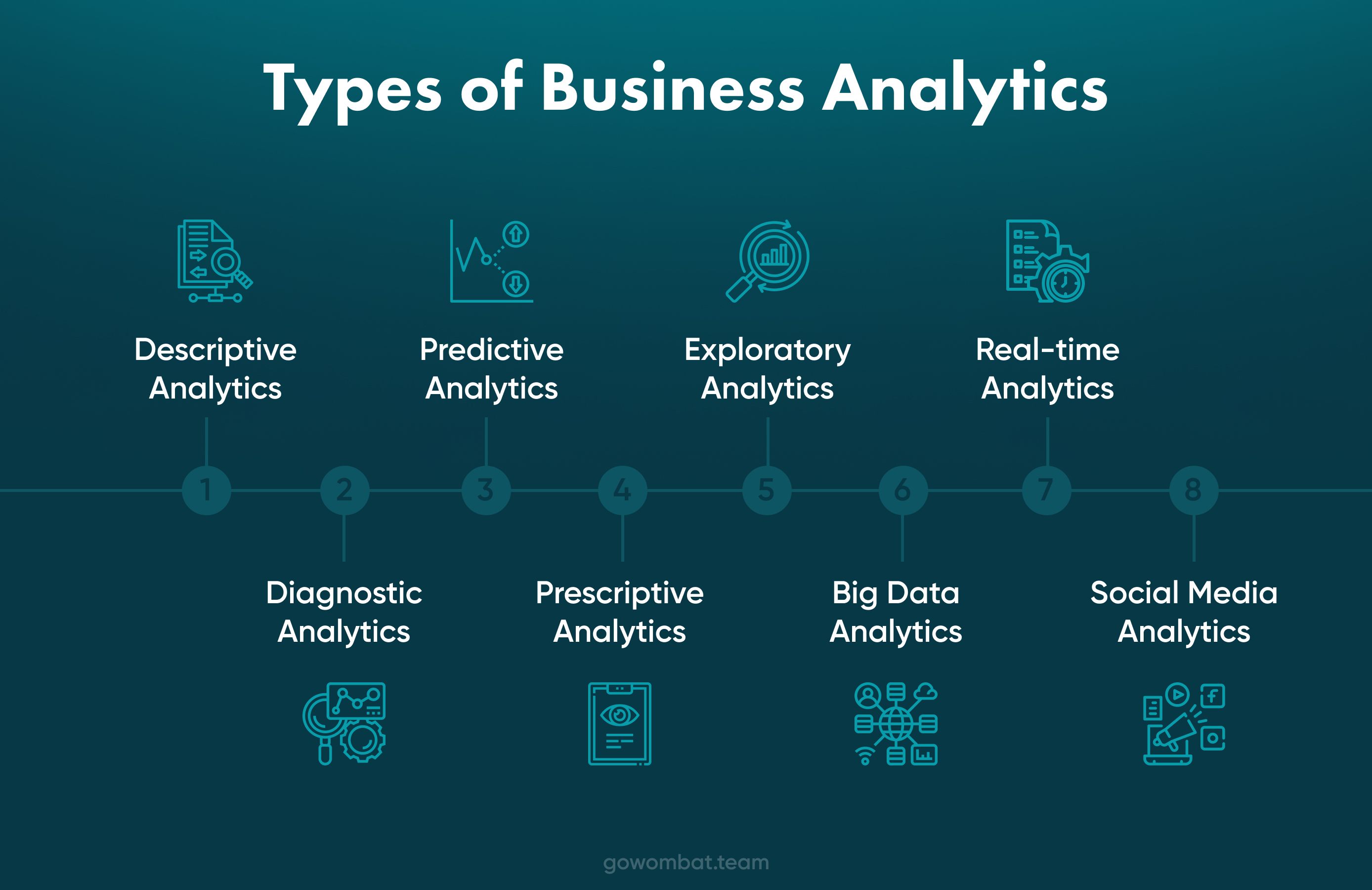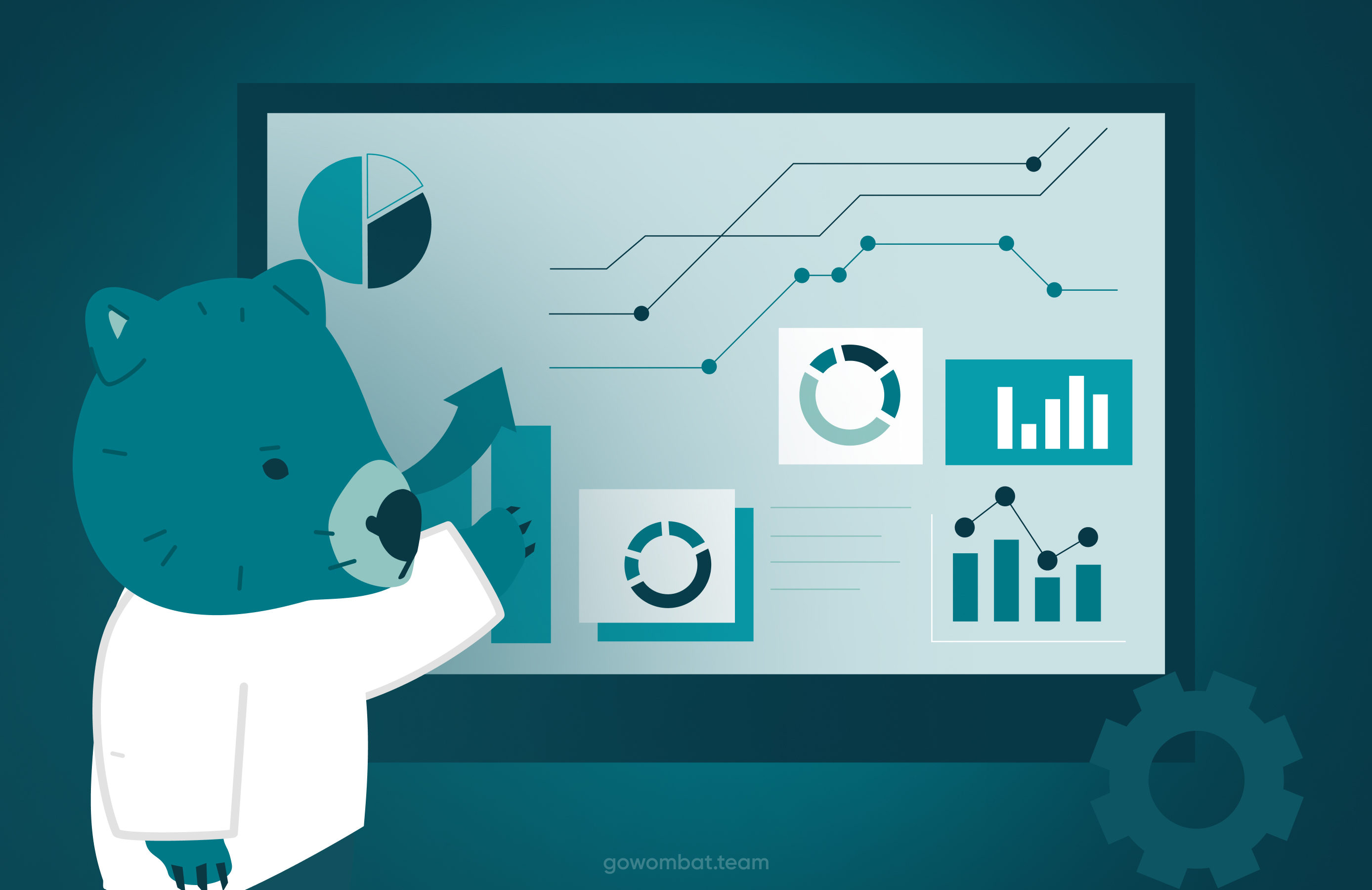Types of Business Analytics


Business analytics is the process of examining data and information to understand trends, patterns, and insights that can inform strategic decision-making within an organisation. It involves gathering, interpreting, and analysing data from various sources to uncover valuable insights that drive business growth and efficiency. In today's digital age, where data is abundant and crucial for gaining a competitive edge, mastering the art of data analysis is not just advantageous but essential. Business analytics emerges as a beacon in this data-driven landscape, offering methodologies and tools that convert raw data into valuable insights. This diverse field encompasses specialised methods tailored to different stages of data analysis and decision-making processes. It empowers organisations to make well-informed, strategic decisions that drive growth and operational efficiency. Business analytics encompasses various types, each serving a specific purpose in the data analysis process. Let's delve into the most prominent types of business analytics, including descriptive, diagnostic, predictive, and prescriptive analytics, as well as explore niche areas like exploratory, big data, real-time, and social media analytics.

Descriptive Analytics
Imagine sitting around a campfire, sharing stories of adventures past, each tale rich with detail and emotion. This is what descriptive analytics brings to the business world. It digs through the history books of data to tell the story of a company's journey. Think of it as the groundwork for all business decision-making, shedding light on successes and learning moments alike.
Descriptive analytics employs a variety of tools and techniques, including statistical analysis, data visualisation, and dashboard reporting, to create an accessible narrative of past business activities. For instance, a retail company might use descriptive analytics to assess sales data, identifying which products sold best during a particular season or understand customer foot traffic patterns. These insights allow businesses to measure their performance and identify areas for improvement or growth.
Diagnostic Analytics
Where descriptive analytics sketches the past, diagnostic analytics delves into the intricacies of why certain events unfolded as they did. Picture yourself as a detective, piecing together clues to unveil the mysteries behind each storyline. This analytical approach employs a more granular examination of data to identify the causative factors behind observed trends and outcomes.
Consider a scenario where a company notices a significant fluctuation in product demand. Diagnostic analytics steps in as the investigative tool, employing techniques such as correlation analysis, regression modelling, and anomaly detection to unearth the root causes. Whether it's external factors like market dynamics or internal changes in operational strategies, diagnostic analytics provides the analytical lens to view beyond the surface, offering insights into the 'why' behind every 'what.'
Predictive Analytics
Armed with an understanding of trends and causative factors, predictive analytics propels businesses into the area of foresight. It's akin to gazing into a crystal ball, with data and algorithms replacing mystical powers to forecast the future. This forward-looking approach leverages statistical models, machine learning algorithms, and pattern recognition to predict upcoming trends, behaviours, and potential risks.
For example, an insurance company might use predictive analytics to assess the possibility of claims based on customer profiles, driving patterns, and historical claim data. Similarly, a retailer could predict future sales trends, enabling precise inventory management and marketing strategies. Predictive analytics not only prepares businesses for forthcoming challenges but also uncovers opportunities for proactive engagement and strategic planning.
Prescriptive Analytics
Once the future is forecasted, prescriptive analytics takes centre stage, acting as the strategic advisor that charts the optimal course of action. It transcends predictive insights, offering not just a glimpse into what might happen but also delivering actionable recommendations on how to navigate the future landscape. Prescriptive analytics employs sophisticated algorithms, simulation models, and optimization techniques to evaluate possible outcomes and prescribe the best path forward.
Imagine a shipping company grappling with the challenge of optimising its delivery routes. Prescriptive analytics can simulate various routing scenarios, taking into account traffic conditions, delivery deadlines, and fuel costs, to recommend the most efficient and cost-effective routes. On a broader scale, it can guide strategic decisions such as market entry strategies, investment allocations, and product development priorities, ensuring that businesses not only predict the future but actively shape it to their advantage.
Exploratory Analytics
Embark on a voyage of discovery with exploratory analytics, the beacon for those seeking to uncover hidden gems within their data without predefined questions or hypotheses. This approach is akin to an explorer venturing into uncharted territories, guided by intuition and the spirit of discovery. Exploratory analytics is about sifting through data in an open-ended search for patterns, anomalies, and correlations that have not been previously considered.
For instance, a healthcare provider could delve into patient data, discovering unexpected patterns in treatment outcomes that could lead to innovative care strategies. Or, a music streaming service might uncover new listener segments with unique preferences, opening up opportunities for tailored playlists and targeted marketing campaigns. By embracing a curious mindset, exploratory analytics enables businesses to unearth insights that lie beyond the reach of traditional analysis, sparking innovation and driving strategic exploration.
Big Data Analytics
In an era where data is generated at an unprecedented scale, big data analytics stands as the titan tasked with taming this digital deluge. It's about harnessing the vast, varied, and velocity-driven data streams - structured and unstructured - to extract meaningful insights. Big data analytics employs advanced technologies and methodologies to process and analyse these colossal datasets, revealing patterns, trends, and insights that inform decision-making and strategic planning.
Imagine an e-commerce giant analysing petabytes of customer interaction data to personalise shopping experiences or a city using big data analytics to optimise traffic flow and public transportation in real time. Big data analytics enables organisations to navigate the complexities of massive data volumes, transforming the challenges of scale into opportunities for insight, innovation, and competitive advantage.
Real-time Analytics
The digital world waits for no one, and real-time analytics ensures businesses don't have to. By analysing data as it's generated, real-time analytics provides instant insights that allow companies to act swiftly and decisively. Whether it's adjusting prices in a fiercely competitive market or monitoring cybersecurity threats as they emerge, real-time analytics equips businesses with the agility to respond to dynamic conditions and capitalise on fleeting opportunities.
Consider the power of real-time analytics in a sporting event, where advertisers adjust their messaging based on live game developments, or in emergency response management, where immediate analysis of incoming data can save lives. By enabling decision-making at the speed of now, real-time analytics transforms data into a great tool for immediate action and strategic agility.
Social Media Analytics
As conversations and interactions increase across social media platforms, social media analytics provides businesses with the ears to listen to the digital pulse. This specialised form of analytics sifts through likes, shares, comments, and trends to gauge brand sentiment, track consumer behaviour, and identify emerging market trends. It offers a direct line to understanding how brands are perceived in the digital sphere, what drives engagement, and how to foster stronger connections with audiences.
By analysing social media data, a brand can quickly pivot its marketing strategy in response to real-time feedback, identify influencers and advocates, and spot early signs of shifting consumer preferences. Social media analytics turns the vast and noisy social media landscape into a strategic asset, enabling businesses to engage authentically with their audience and stay ahead of the curve.
Conclusive Insight

As we journey through the diverse kinds of business analytics - from the historical depths of descriptive analytics to the innovative peaks of social media analytics - the undeniable value of data as a strategic compass becomes clear. Each analytical approach, with its unique perspective and methodology, equips businesses with the insights needed to navigate the complexities of the modern marketplace.
In embracing the full spectrum of business analytics, organisations unlock the potential to not only interpret their past and present but also to anticipate and shape their future. This exploration is not merely an academic endeavour; it's a practical guide for leveraging data as a catalyst for growth, efficiency, and innovation.
Business analytics serves as a cornerstone in shaping strategic decisions and fostering innovation across various industries, including software development. At Go Wombat, we understand the critical importance of business analytics in software development. Our expertise extends beyond coding and design; we offer comprehensive business analysis services to ensure that every solution we develop is aligned with your objectives and backed by data-driven insights. Let us empower your business with intelligent software solutions. Contact us today to start your journey towards success.
Unlock Success with Premium Software Development
Contact us


Business Analytics FAQs
What is the business analytics process?
The business analytics process typically involves data collection, data processing, data analysis, and decision-making based on insights derived from the analysis.
What are business analytics models?
Business analytics models consist of statistical models, machine learning models, and predictive models.
What is the role of a business analyst?
A business analyst plays a vital role in bridging the gap between business needs and IT resources by analysing data, defining requirements, and recommending solutions.
What are the main types of data?
Main types of data in business analytics are transactional data, customer data, and operational data.
What is big data?
Big data refers to extremely large and complex datasets that cannot be effectively processed using traditional data processing applications.
What are the types of big data?
Types of big data include structured, unstructured, and semi-structured data, along with social media data, sensor data, and multimedia data.
How can we help you ?






